Archives
-
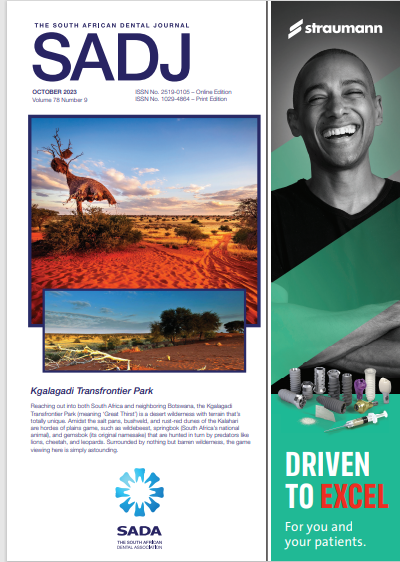
The South African Dental Journal
Vol. 78 No. 09 (2023)Reaching out into both South Africa and neighboring Botswana, the Kgalagadi Transfrontier Park (meaning ‘Great Thirst’) is a desert wilderness with terrain that’stotally unique. Amidst the salt pans, bushveld, and rust-red dunes of the Kalahari are hordes of plains game, such as wildebeest, springbok (South Africa’s national animal), and gemsbok (its original namesake) that are hunted in turn by predators like lions, cheetah, and leopards. Surrounded by nothing but barren wilderness, the game
viewing here is simply astounding. -
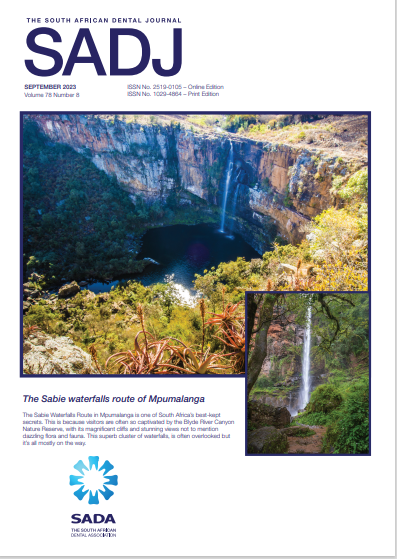
The South African Dental Journal
Vol. 78 No. 08 (2023)The Sabie waterfalls route of Mpumalanga
The Sabie Waterfalls Route in Mpumalanga is one of South Africa’s best-kept secrets. This is because visitors are often so captivated by the Blyde River Canyon Nature Reserve, with its magnificent cliffs and stunning views not to mention dazzling flora and fauna. This superb cluster of waterfalls, is often overlooked but it’s all mostly on the way -
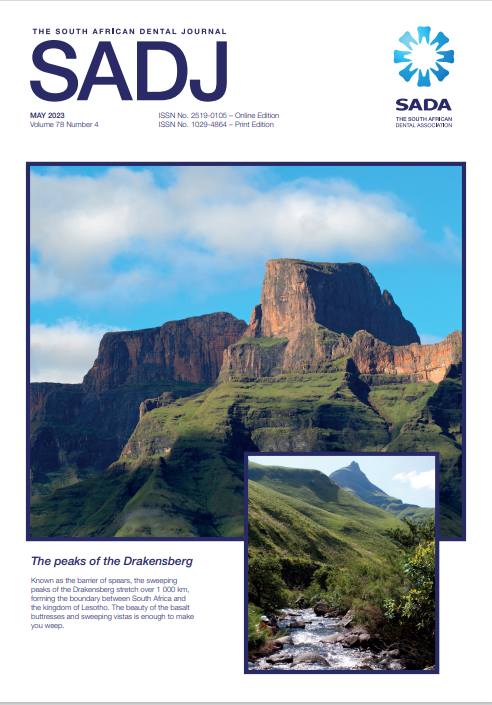
The South African Dental Journal
Vol. 78 No. 04 (2023)The peaks of the Drakensberg
Known as the barrier of spears, the sweeping peaks of the Drakensberg stretch over 1 000 km, forming the boundary between South Africa and the kingdom of Lesotho. The beauty of the basalt buttresses and sweeping vistas is enough to make you weep. -
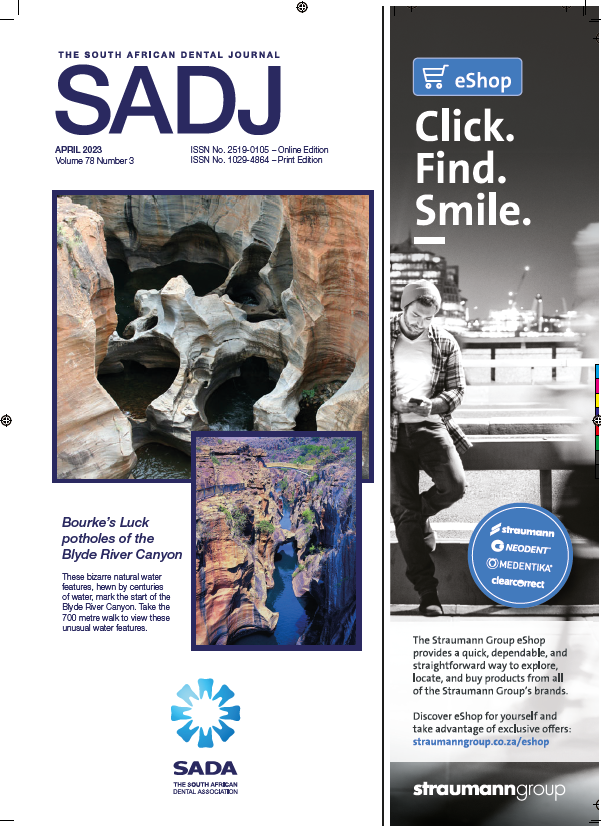
The South African Dental Journal
Vol. 78 No. 03 (2023)Bourke’s Luck potholes of the Blyde River Canyon
These bizarre natural water features, hewn by centuries of water, mark the start of the Blyde River Canyon. Take the 700 metre walk to view these unusual water features. -
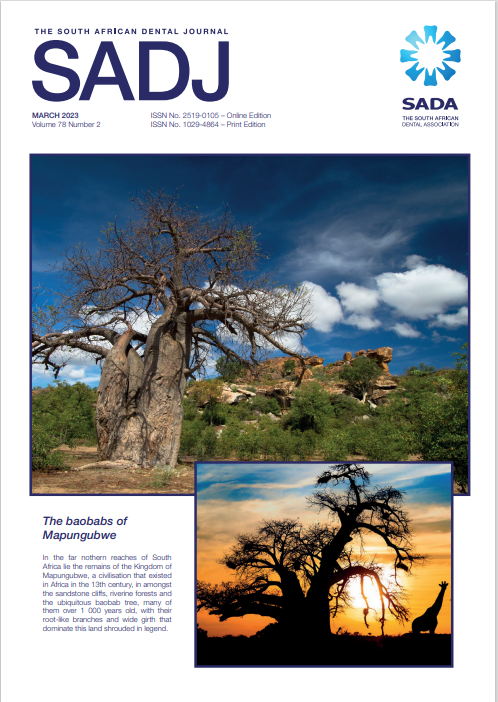
The South African Dental Journal
Vol. 78 No. 02 (2023)The baobabs of Mapungubwe
In the far nothern reaches of South Africa lie the remains of the Kingdom of Mapungubwe, a civilisation that existed in Africa in the 13th century, in amongst the sandstone cliffs, riverine forests and the ubiquitous baobab tree, many of them over 1 000 years old, with their root-like branches and wide girth that dominate this land shrouded in legend. -
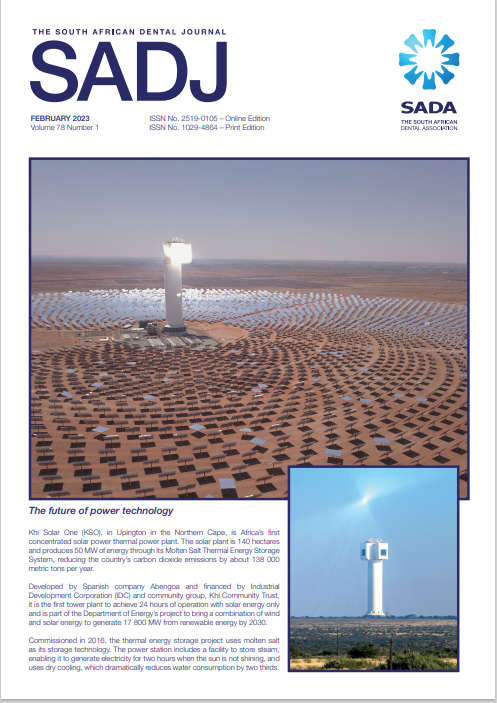
The South African Dental Journal
Vol. 78 No. 01 (2023)Khi Solar One (KSO), in Upington in the Northern Cape, is Africa’s first concentrated solar power thermal power plant. The solar plant is 140 hectares and produces 50 MW of energy through its Molten Salt Thermal Energy Storage System, reducing the country’s carbon dioxide emissions by about 138 000
metric tons per year. Developed by Spanish company Abengoa and financed by Industrial Development Corporation (IDC) and community group, Khi Community Trust, it is the first tower plant to achieve 24 hours of operation with solar energy only and is part of the Department of Energy’s project to bring a combination of wind and solar energy to generate 17 800 MW from renewable energy by 2030.
Commissioned in 2016, the thermal energy storage project uses molten salt as its storage technology. The power station includes a facility to store steam, enabling it to generate electricity for two hours when the sun is not shining, and uses dry cooling, which dramatically reduces water consumption by two thirds. -
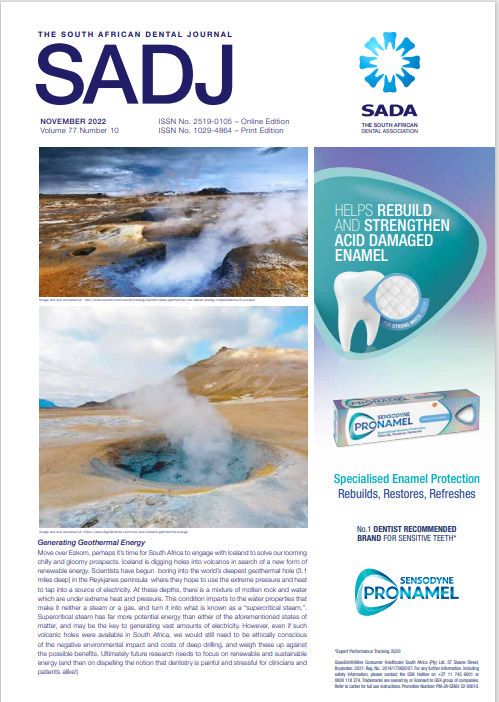
The South African Dental Journal
Vol. 77 No. 10 (2022)Move over Eskom, perhaps it’s time for South Africa to engage with Iceland to solve our looming
chilly and gloomy prospects. Iceland is digging holes into volcanos in search of a new form of
renewable energy. Scientists have begun boring into the world’s deepest geothermal hole (3.1
miles deep) in the Reykjanes peninsula where they hope to use the extreme pressure and heat
to tap into a source of electricity. At these depths, there is a mixture of molten rock and water
which are under extreme heat and pressure. This condition imparts to the water properties that
make it neither a steam or a gas, and turn it into what is known as a “supercritical steam,”.
Supercritical steam has far more potential energy than either of the aforementioned states of
matter, and may be the key to generating vast amounts of electricity. However, even if such
volcanic holes were available in South Africa, we would still need to be ethically conscious
of the negative environmental impact and costs of deep drilling, and weigh these up against
the possible benefits. Ultimately future research needs to focus on renewable and sustainable
energy (and then on dispelling the notion that dentistry is painful and stressful for clinicians and
patients alike!) -
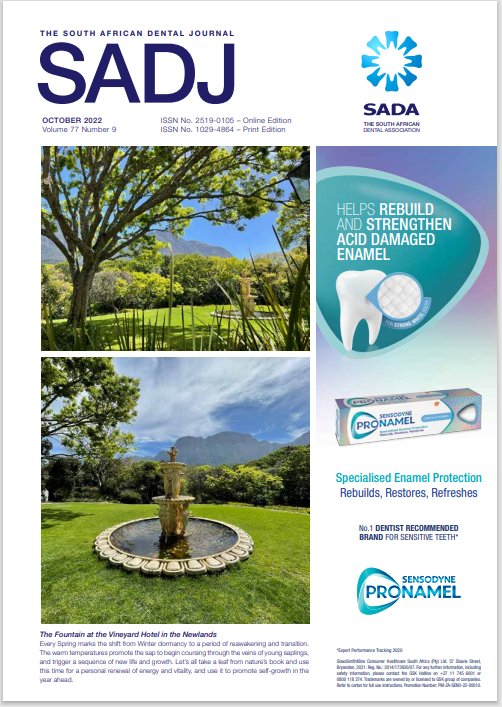
The South African Dental Journal
Vol. 77 No. 09 (2022)Every Spring marks the shift from Winter dormancy to a period of reawakening and transition. The warm temperatures promote the sap to begin coursing through the veins of young saplings, and trigger a sequence of new life and growth. Let’s all take a leaf from nature’s book and use this time for a personal renewal of energy and vitality, and use it to promote self-growth in the year ahead.
-
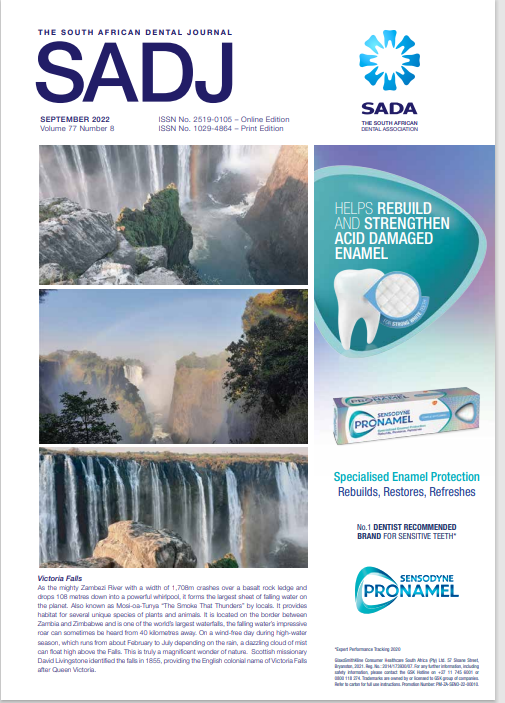
The South African Dental Journal
Vol. 77 No. 08 (2022)As the mighty Zambezi River with a width of 1,708m crashes over a basalt rock ledge and drops 108 metres down into a powerful whirlpool, it forms the largest sheet of falling water on the planet. Also known as Mosi-oa-Tunya “The Smoke That Thunders” by locals. It provides habitat for several unique species of plants and animals. It is located on the border between Zambia and Zimbabwe and is one of the world’s largest waterfalls, the falling water’s impressive roar can sometimes be heard from 40 kilometres away. On a wind-free day during high-water season, which runs from about February to July depending on the rain, a dazzling cloud of mist can float high above the Falls. This is truly a magnificent wonder of nature. Scottish missionary David Livingstone identified the falls in 1855, providing the English colonial name of Victoria Falls after Queen Victoria.
-
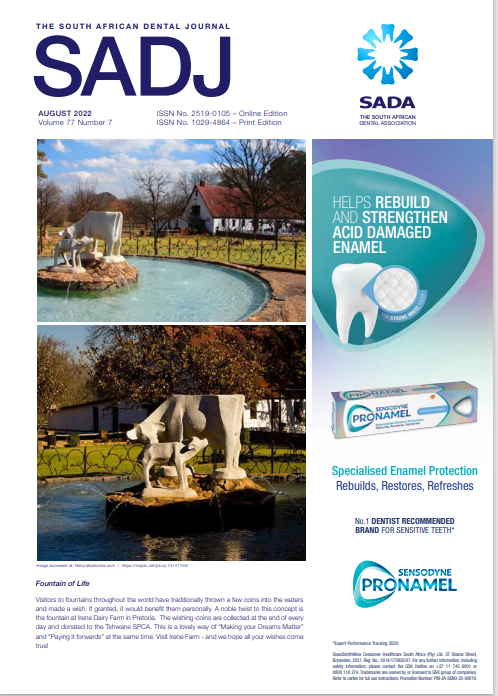
The South African Dental Journal
Vol. 77 No. 07 (2022)Fountain of Life
Visitors to fountains throughout the world have traditionally thrown a few coins into the waters
and made a wish. If granted, it would benefit them personally. A noble twist to this concept is
the fountain at Irene Dairy Farm in Pretoria. The wishing-coins are collected at the end of every
day and donated to the Tshwane SPCA. This is a lovely way of “Making your Dreams Matter”
and “Paying it forwards” at the same time. Visit Irene Farm - and we hope all your wishes come
true! -
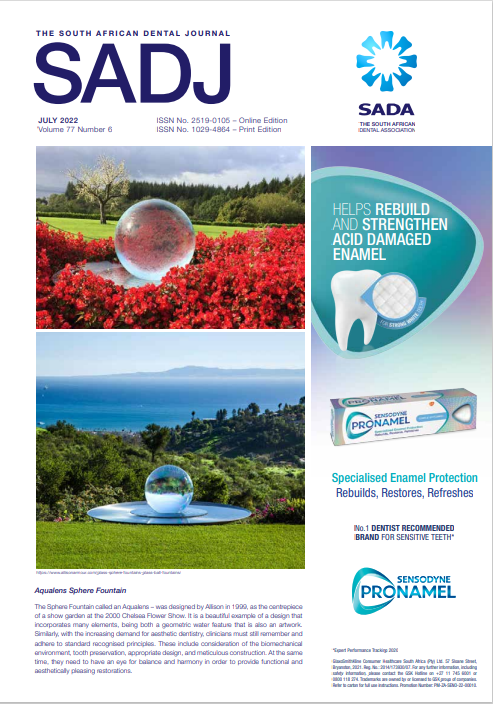
The South African Dental Journal
Vol. 77 No. 06 (2022)The Sphere Fountain called an Aqualens – was designed by Allison in 1999, as the centrepiece
of a show garden at the 2000 Chelsea Flower Show. It is a beautiful example of a design that
incorporates many elements, being both a geometric water feature that is also an artwork.
Similarly, with the increasing demand for aesthetic dentistry, clinicians must still remember and
adhere to standard recognised principles. These include consideration of the biomechanical
environment, tooth preservation, appropriate design, and meticulous construction. At the same
time, they need to have an eye for balance and harmony in order to provide functional and
aesthetically pleasing restorations. -
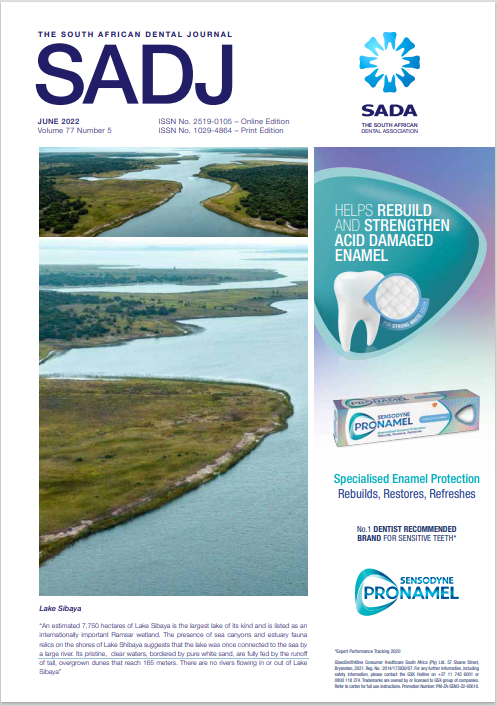
The South African Dental Journal
Vol. 77 No. 05 (2022)Lake Sibaya
“An estimated 7,750 hectares of Lake Sibaya is the largest lake of its kind and is listed as an internationally important Ramsar wetland. The presence of sea canyons and estuary fauna relics on the shores of Lake Shibaya suggests that the lake was once connected to the sea by a large river. Its pristine, clear waters, bordered by pure white sand, are fully fed by the runoff of tall, overgrown dunes that reach 165 meters. There are no rivers flowing in or out of Lake Sibaya” -
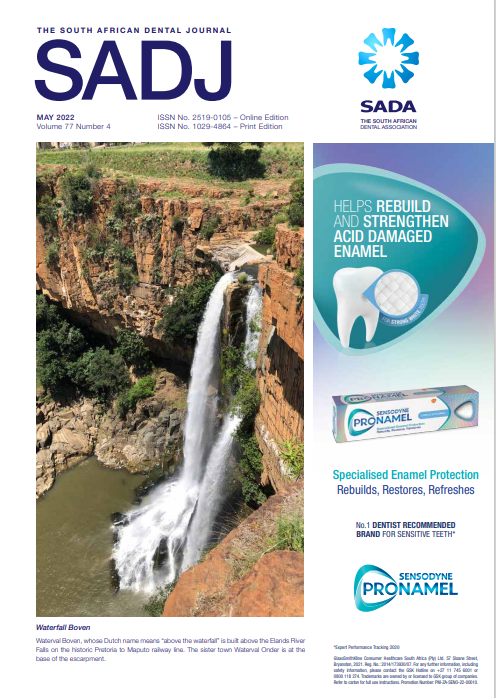
The South African Dental Journal
Vol. 77 No. 04 (2022)Waterfall Boven
Waterval Boven, whose Dutch name means “above the waterfall” is built above the Elands River Falls on the historic Pretoria to Maputo railway line. The sister town Waterval Onder is at the base of the escarpment. -
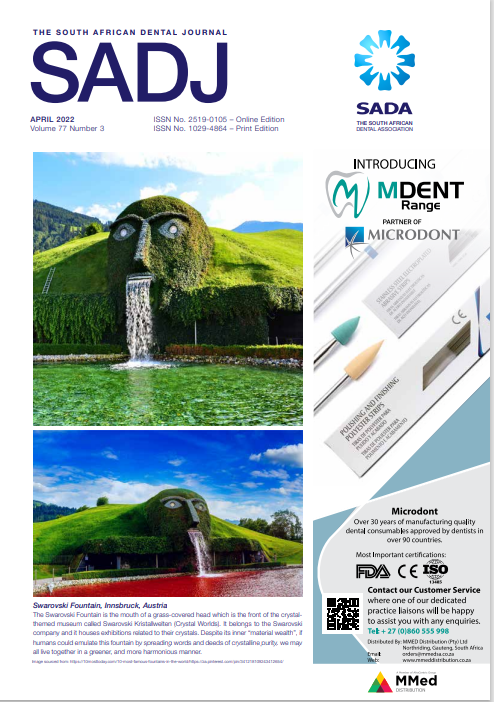
The South African Dental Journal
Vol. 77 No. 03 (2022)Swarovski Fountain, Innsbruck, Austria
The Swarovski Fountain is the mouth of a grass-covered head which is the front of the crystal themed museum called Swarovski Kristallwelten (Crystal Worlds). It belongs to the Swarovski company and it houses exhibitions related to their crystals. Despite its inner “material wealth”, if humans could emulate this fountain by spreading words and deeds of crystalline purity, we may all live together in a greener, and more harmonious manner. -
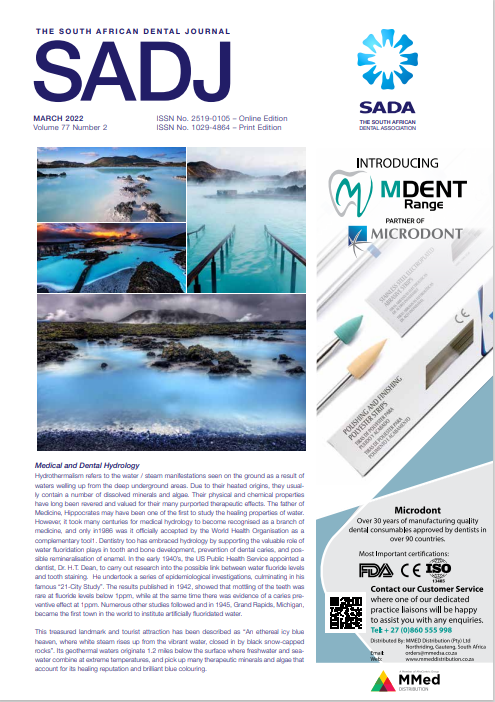
The South African Dental Journal
Vol. 77 No. 02 (2022)Medical and Dental Hydrology
Hydrothermalism refers to the water / steam manifestations seen on the ground as a result of
waters welling up from the deep underground areas. Due to their heated origins, they usually contain a number of dissolved minerals and algae. Their physical and chemical properties have long been revered and valued for their many purported therapeutic effects. The father of Medicine, Hippocrates may have been one of the first to study the healing properties of water. However, it took many centuries for medical hydrology to become recognised as a branch of medicine, and only in1986 was it officially accepted by the World Health Organisation as a complementary tool1. Dentistry too has embraced hydrology by supporting the valuable role of water fluoridation plays in tooth and bone development, prevention of dental caries, and possible remineralisation of enamel. In the early 1940’s, the US Public Health Service appointed a dentist, Dr. H.T. Dean, to carry out research into the possible link between water fluoride levels and tooth staining. He undertook a series of epidemiological investigations, culminating in his famous “21-City Study”. The results published in 1942, showed that mottling of the teeth was rare at fluoride levels below 1ppm, while at the same time there was evidence of a caries preventive effect at 1ppm. Numerous other studies followed and in 1945, Grand Rapids, Michigan,
became the first town in the world to institute artificially fluoridated water. This treasured landmark and tourist attraction has been described as “An ethereal icy blue heaven, where white steam rises up from the vibrant water, closed in by black snow-capped rocks”. Its geothermal waters originate 1.2 miles below the surface where freshwater and seawater combine at extreme temperatures, and pick up many therapeutic minerals and algae that account for its healing reputation and brilliant blue colouring. -
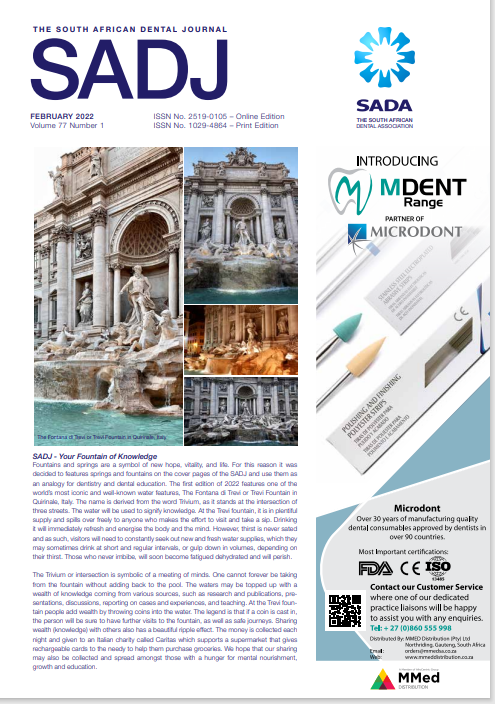
The South African Dental Journal
Vol. 77 No. 01 (2022)SADJ - Your Fountain of Knowledge
Fountains and springs are a symbol of new hope, vitality, and life. For this reason it was decided to features springs and fountains on the cover pages of the SADJ and use them as an analogy for dentistry and dental education. The first edition of 2022 features one of the world’s most iconic and well-known water features, The Fontana di Trevi or Trevi Fountain in Quirinale, Italy. The name is derived from the word Trivium, as it stands at the intersection of three streets. The water will be used to signify knowledge. At the Trevi fountain, it is in plentiful supply and spills over freely to anyone who makes the effort to visit and take a sip. Drinking it will immediately refresh and energise the body and the mind. However, thirst is never sated and as such, visitors will need to constantly seek out new and fresh water supplies, which they may sometimes drink at short and regular intervals, or gulp down in volumes, depending on their thirst. Those who never imbibe, will soon become fatigued dehydrated and will perish. The Trivium or intersection is symbolic of a meeting of minds. One cannot forever be taking from the fountain without adding back to the pool. The waters may be topped up with a wealth of knowledge coming from various sources, such as research and publications, presentations, discussions, reporting on cases and experiences, and teaching. At the Trevi fountain people add wealth by throwing coins into the water. The legend is that if a coin is cast in, the person will be sure to have further visits to the fountain, as well as safe journeys. Sharing wealth (knowledge) with others also has a beautiful ripple effect. The money is collected each night and given to an Italian charity called Caritas which supports a supermarket that gives
rechargeable cards to the needy to help them purchase groceries. We hope that our sharing may also be collected and spread amongst those with a hunger for mental nourishment, growth and education -
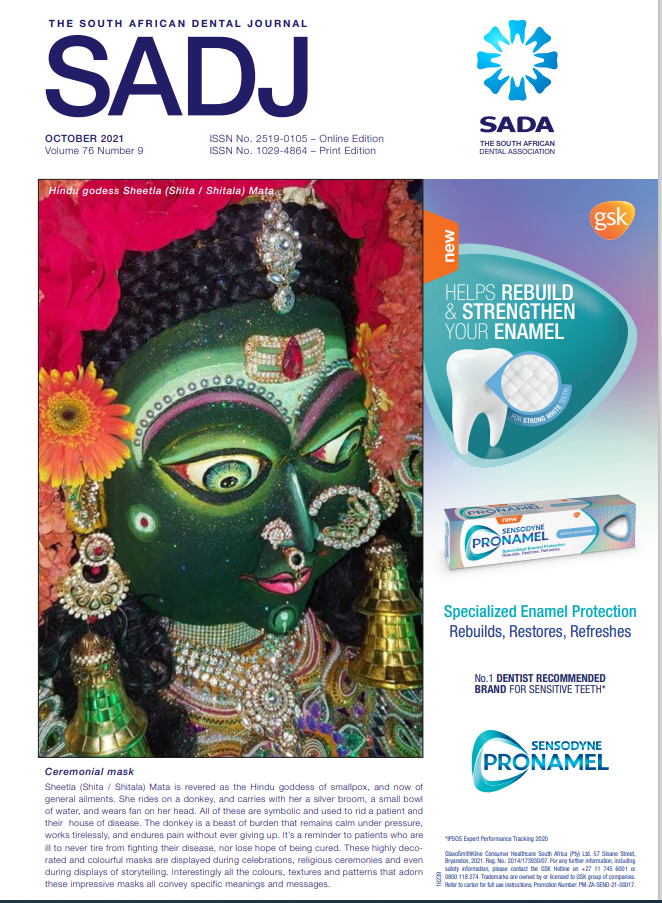
The South African Dental Journal
Vol. 76 No. 09 (2021)Ceremonial mask
Sheetla (Shita / Shitala) Mata is revered as the Hindu goddess of smallpox, and now of general ailments. She rides on a donkey, and carries with her a silver broom, a small bowl of water, and wears fan on her head. All of these are symbolic and used to rid a patient and their house of disease. The donkey is a beast of burden that remains calm under pressure, works tirelessly, and endures pain without ever giving up. It’s a reminder to patients who are ill to never tire from fighting their disease, nor lose hope of being cured. These highly decorated and colourful masks are displayed during celebrations, religious ceremonies and even during displays of storytelling. Interestingly all the colours, textures and patterns that adorn these impressive masks all convey specific meanings and messages. -
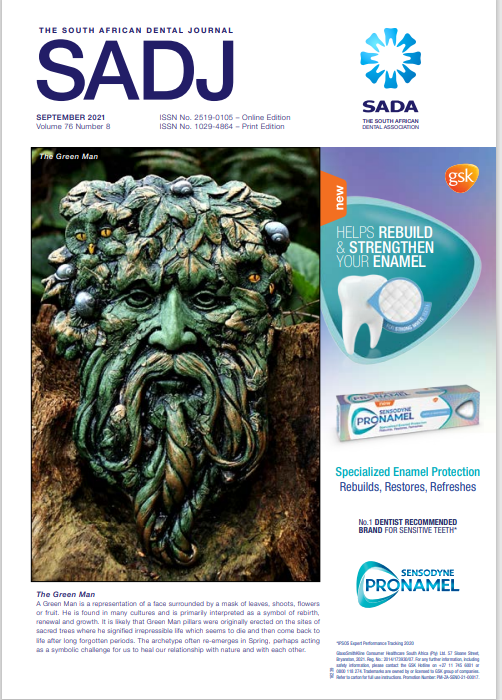
The South African Dental Journal
Vol. 76 No. 08 (2021)The Green Man
A Green Man is a representation of a face surrounded by a mask of leaves, shoots, flowers or fruit. He is found in many cultures and is primarily interpreted as a symbol of rebirth, renewal and growth. It is likely that Green Man pillars were originally erected on the sites of sacred trees where he signified irrepressible life which seems to die and then come back to life after long forgotten periods. The archetype often re-emerges in Spring, perhaps acting as a symbolic challenge for us to heal our relationship with nature and with each other.

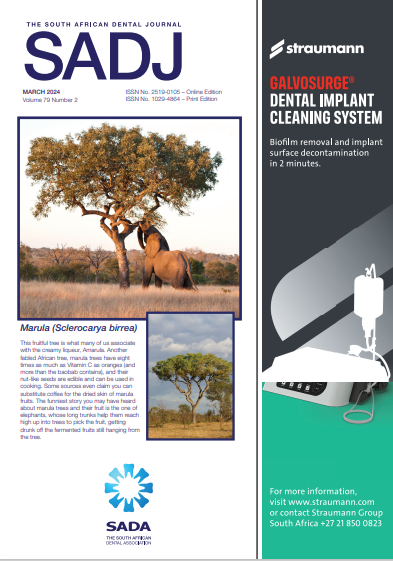
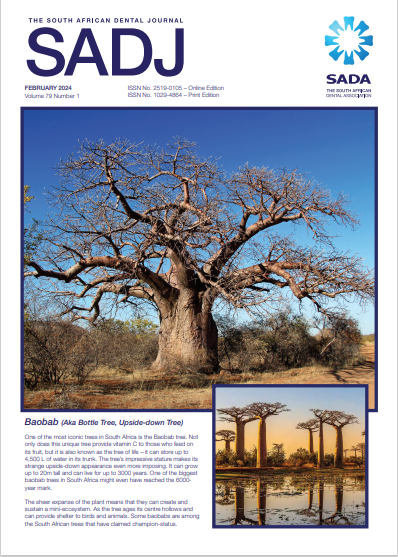
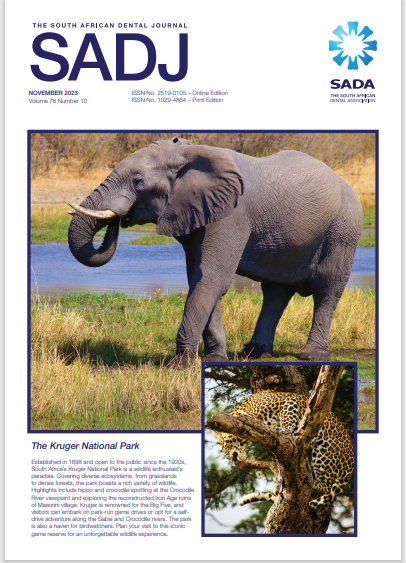
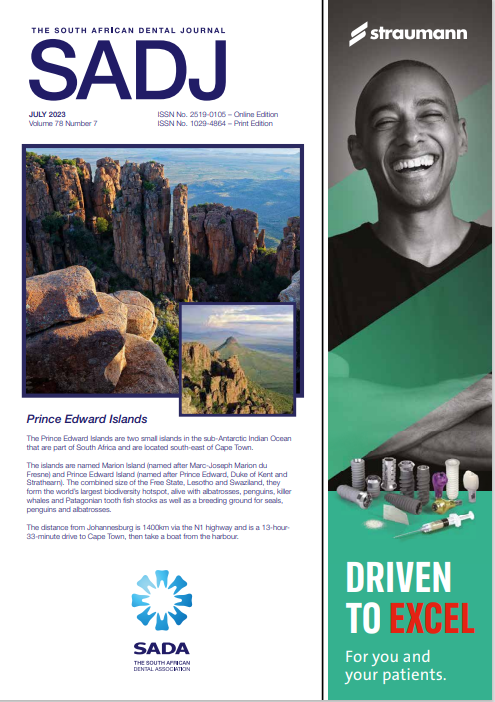
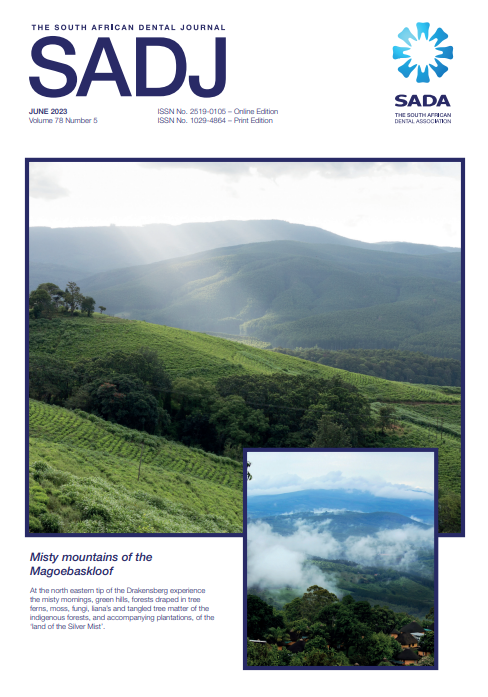
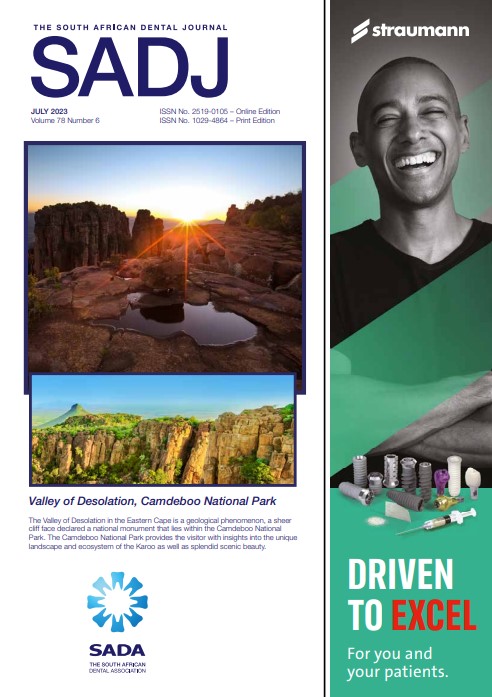
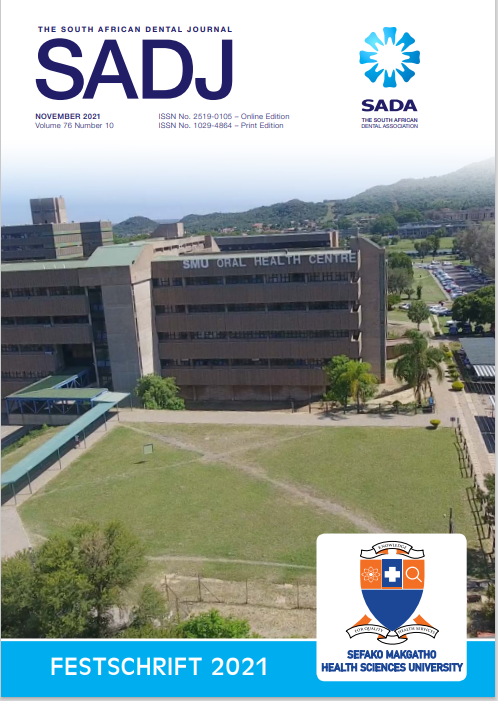



.png)